Remote Shutter Control for X Series Cameras
Talk to Rico (questions & feedback) – Rico’s Flickr photosteam
Releasing the shutter of your camera remotely can have several advantages. For once, not touching the camera reduces shake and vibrations, which is especially important at slow shutter speeds. Mounting the camera on a tripod is only half of the solution. Yes, you can use the camera’s self-timer function for hands-free operation, but it’s hard (if not impossible) to catch decisive moments with this method.
Other applications of remote shutter release devices are placing the camera at hard to reach locations or producing a series of well-timed shots for time-lapse or HDR photography. Advanced timing solutions incorporate wireless operation (infrared, radio-controlled, Bluetooth or WLAN), and they can be triggered by certain GPS coordinates or position changes (like taking a shot every 50 meters while moving in a car), by a person stepping in front of the camera (recognizing faces or movement) or by rather exotic stuff like changes in the magnetic field.
Sadly, Fujifilm doesn’t offer a common remote triggering interface in its X series: With the XF1, there’s no option to externally trigger the shutter at all, so all you can do is using the self-timer. The X10, X20, X100, X100S, X-Pro1 and X-E1 offer classic threads for manual screw-in cable releases. The X-S1 and X-E1 feature an option to electronically release the shutter through the so-called RR-80 port (which hides in the Mini-USB port of these cameras, using pins number 4 and 5), and in addition to that, the X-E1 allows the microphone input socket to moonlight as a remote trigger input that is compatible with a substantial range of camera makes and models, offering a large number of options of remote triggering devices that can be used in concert with this camera.
Classic Mechanical Cable Release
Cable releases can perform the same three basic functions as your camera’s shutter button:
- half-pressing the shutter to establish/lock focus and exposure
- fully depressing the shutter to take the shot
- keeping the shutter depressed (and locked) for an extended period of time to take long-time exposures (bulb mode)
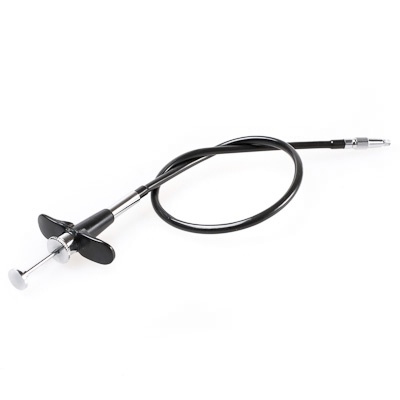
Cable releases come in several forms and usually don’t cost much. There’s no need to get a fancy model (unless you like fancy stuff), just make sure it operates smoothly.
As mentioned earlier, cable releases are compatible with the X10, X20, X100, X100S, X-Pro1 and X-E1.
RR-80 Electronic Release
Just because its interface is electronic doesn’t mean that connecting an [shoplink 12241]RR-80[/shoplink] based remote shutter release adds additional functionality beyond a mechanical cable release. An electronic RR-80 trigger will merely perform the very same three functions:
- half-pressing the shutter to establish/lock focus and exposure
- fully depressing the shutter to take the shot
- keeping the shutter depressed (and locked) for an extended period of time to take long-time exposures (bulb mode)
Beyond that, there’s no communication going on between the camera and the remote: The remote isn’t aware of any camera settings, and the camera isn’t aware what’s set on the remote. Here’s an example of a simple electronic RR-80 trigger that’s available as an accessory from Fujifilm:
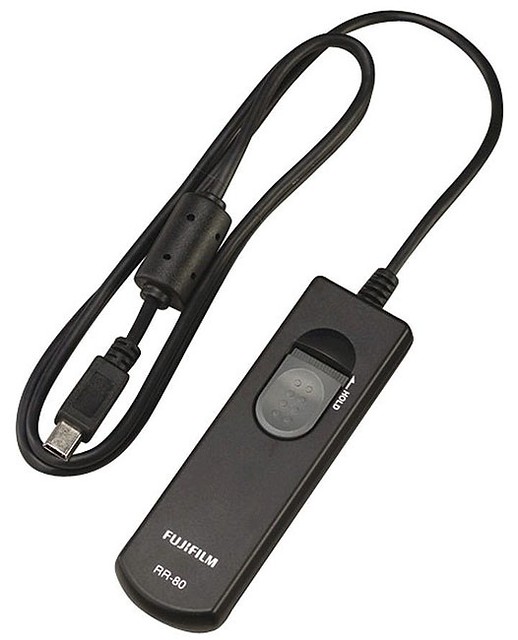
There are several RR-80 compatible “no-name” options available, with some of them offering wireless operation or sophisticated interval timers. Here’s an example of an intervalometer…

…and here’s a pretty basic but functional radio-controlled remote trigger:
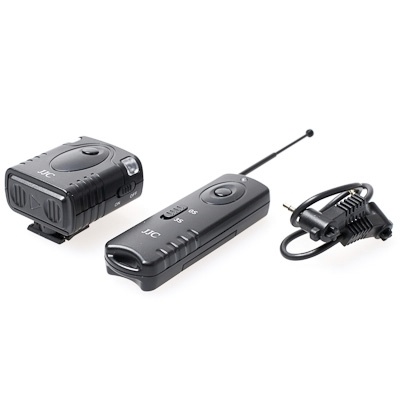
While an intervalometer is useful for time-lapse photography, a radio trigger will allow you to place the camera at difficult-to-reach or dangerous locations, like on a car or on a pole.
RR-80 devices work with the Fujifilm X-S1 and X-E1. Since RR-80 is an analog hardware option using two Mini-USB ports (but is not transmitting any digital data to the camera processor via USB protocols), there’s no way the X10, X20, X100, X100S or X-Pro1 could become RR-80 compatible through a firmware update. This isn’t a software issue, those cameras are lacking RR-80 compatible wiring to electronically trigger the shutter from the outside.
Microphone Input Port Triggering
[shoplink 12241]RR-80[/shoplink] is a pretty much Fujifilm-specific (and hence rather “exotic”) interface, but the internal microphone port trigger of the X-E1 is not. In fact, this port and its triggering protocol are compatible with a broad range of cameras, including the Canon Digital Rebel, Canon EOS 1000D, Canon EOS 100D, Canon EOS 1100D, Canon EOS 300D, Canon EOS 350D, Canon EOS 400D, Canon EOS 450D, Canon EOS 500D, Canon EOS 550D, Canon EOS 600D, Canon EOS 60D, Canon EOS 60Da, Canon EOS 650D, Canon EOS 700D, Canon Kiss Digital, Canon Kiss F Digital, Canon Kiss N, Canon Kiss X2, Canon Kiss X3, Canon Kiss X4, Canon Kiss X5, Canon Kiss X50, Canon Kiss X6, Canon PowerShot G1 X, Canon PowerShot G10, Canon PowerShot G11, Canon PowerShot G12, Canon PowerShot G15, Canon PowerShot SX50 HS, Canon Rebel SL1, Canon Rebel T1i, Canon Rebel T2i, Canon Rebel T3, Canon Rebel T3i, Canon Rebel T4i, Canon Rebel XS, Canon Rebel XSi, Canon Rebel XT, Canon Rebel XTi, Canon Revel T5i, Contax 645, Contax N, Contax N Digital, Contax N1, Contax NX, Hasselblad H, Hasselblad H3D, Hasselblad H4D-200MS, Hasselblad H4D-31, Hasselblad H4D-40, Hasselblad H4D-50, Hasselblad H4D-50MS, Hasselblad H4D-60, Pentax 645D, Pentax ist D, Pentax ist DL, Pentax ist DL2, Pentax ist DS, Pentax ist DS2, Pentax K-30, Pentax K-5, Pentax K-7, Pentax K-m,Pentax K10 Grand Prix, Pentax K100D, Pentax K100D Super, Pentax K10D, Pentax K110D, Pentax K200D, Pentax K20D, Pentax MZ-6, Pentax MZ-L, Pentax ZX-L, Samsung GX-1L, Samsung GX-1S, Samsung GX-20, Samsung NX-10, Samsung NX-100, Samsung NX-11, Samsung NX-5, Sigma SD1, Sigma SD1 Merrill and Sigma SD15. Whoa!A triggering device that is compatible with any of these cameras is also supposed to trigger your X-E1, so you can choose from a large number of triggering options, one of them being the ingenious Triggertrap software for iOS and Android devices. In connection with a suitable hardware dongle and cable kit, it will trigger your X-E1 electronically via the camera’s external microphone input, which is located at the left side of the chassis.
This is how the Triggertrap dongle and cable look like:
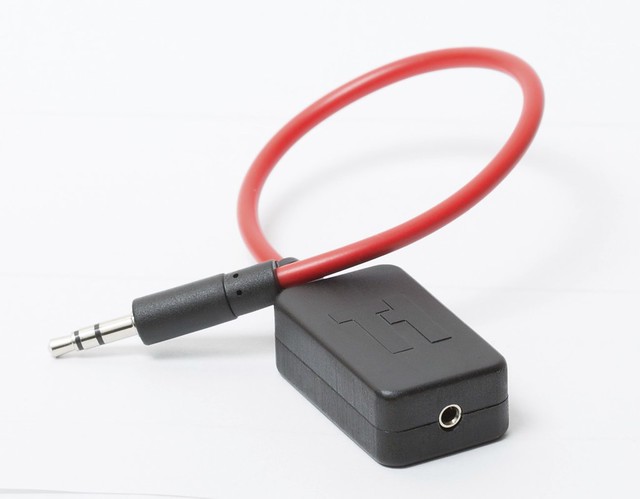
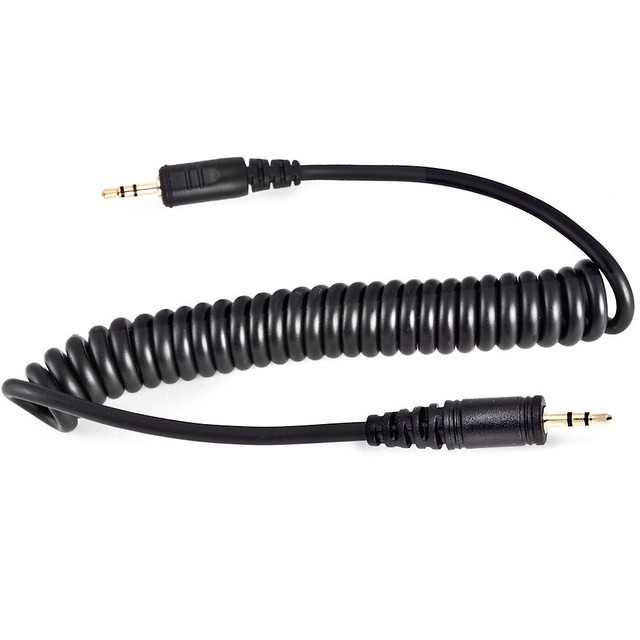
If you already use an iPhone and are looking for a sophisticated and yet affordable triggering solution with a friendly user interface, you may want to consider Triggertrap. The app itself is free, so you can check-it out before buying the hardware interface. The following triggering modes and functions are available:
- Timelapse Mode
- TimeWarp™ Mode
- Sound sensor Mode
- Shock & Vibration sensor Mode
- Metal & magnetism sensor Mode
- Facial recognition Mode
- LE HDR Mode
- LE HDR Timelapse Mode
- DistanceLapse™ Mode
- Motion detection Mode
- Cable Release Mode
- Star trail Mode
- Bulb Ramping Timelapse
- Wi-Fi Slave Mode
- Wi-Fi Master Mode (trigger other devices running Triggertrap Mobile)
- Sunset & Sunrise Calculator
- Lag-o-Meter
If you want to know more about these modes and how they work, I recommend reading the help displays in the free Triggertrap app or having a look at the online PDF manual.
But make no mistake: As sophisticated as it looks, the interface between Triggertrap and the camera is as “dumb” and simple as any mechanical cable release or an [shoplink 12241]RR-80[/shoplink] trigger. There’s no digital communication going on between the camera and Triggertrap, so Triggertrap doesn’t know about any camera settings (and can’t change them, either), and the camera doesn’t know about Triggertrap. This means Triggertrap can merely trigger the shutter with these three familiar functions:
- half-pressing the shutter to establish/lock focus and exposure
- fully depressing the shutter to take the shot
- keeping the shutter depressed (and locked) for an extended period of time to take long-time exposures (bulb mode)
However, Triggertrap offers plenty of options to control when, where, why and how often to release (and hold) the shutter, and it features wireless operation via a Bluetooth device or via a second iOS device (iPhone) and WLAN. The sheer number of options may be overkill for many users, but who says you have to use them all?
For your convenience, here’s a TOC with links to my previous X-PERT CORNER articles:
- Apple Camera RAW, X-Trans and EXR
- First Look: XF55-200mmF3.5-4.8 R LM OIS
- Studio X
- Using the X100S
- Using the X20
- X100S vs. X100
- X20 vs. X10
- RAW, JPEG, Silkypix and “Fuji Colors”
- Adapting Third-Party Lenses (updated with Speed Booster)
- RAW for JPEG Shooters…
- Tips for Updating your Firmware
- How to Clean the X-Trans Sensor
- Using the XF14mmF2.8 R
- Decoding XF18-55mmF2.8-4 R LM OIS
- Comparing RAW converters: JPEG vs. Lightroom, Capture One, Silkypix & RPP
- XF14mmF2.8 R appears to be almost distortion free
- How to Expand Dynamic Range
- How to Use Extended ISO
- EXR, anyone?
- Capture One – When the Going Gets Tough…
- Using Shooting Profiles and the Quick Menu
Rico Pfirstinger studied communications and has been working as journalist, publicist, and photographer since the mid-80s. He has written a number of books on topics as diverse as Adobe PageMaker and sled dogs, and produced a beautiful book of photographs titled Huskies in Action (German version). He has spent time working as the head of a department with the German Burda-Publishing Company and served as chief editor for a winter sports website. After eight years as a freelance film critic and entertainment writer in Los Angeles, Rico now lives in Germany and devotes his time to digital photography and compact camera systems. His book “Mastering the FUJIFILM X-Pro1” (Kindle Edition) (Apple iBook Store) (German version) is available on Amazon and offers a plethora of tips, secrets and background information on successfully using Fuji’s X-Pro1 and X-E1 system cameras, lenses and key accessories.

